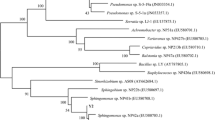Abstract
Sphingorhabdus sp. YGSMI21, a novel microbial strain with an enantioselective epoxide hydrolase activity, was isolated from tidal samples contaminated by accidental oil spills subjected to enriched culture with polycyclic aromatic hydrocarbon. This strain was able to optically decompose (R)-styrene oxide (SO) and showed 100% optical purity. In addition, it showed a good enantioselectivity for the derivatives of (S)-SO, (S)-2-chlorostyrene oxide (CSO), (S)-3-CSO and (S)-4-CSO. For (S)-2-CSO, (S)-3-CSO and (S)-4-CSO, 99.9%ee was obtained with the yield of 26.2%, 24.8%, and 11.0%, respectively, when using 10 mg cells of Sphingorhabdus sp. YGSMI21 at pH 8.0 with 4 mM racemic substrates at pH 8.0 and 25°C. The values obtained in this study for (S)-2-CSO, particularly the yield of 26.2%, is noteworthy, considering that obtaining an enantiomerically pure form is difficult. Taken together, Sphingorhabdus sp. YGSMI21 can be regarded as a whole-cell biocatalyst in the production of various (S)-CSO with the chlorine group at a different position.
Similar content being viewed by others
References
Archelas, A. and Furstoss, R. 1997. Synthesis of enantiopure epoxides through biocatalytic approaches. Annu. Rev. Microbiol. 51, 491–525.
Archelas, A. and Furstoss, R. 2001. Synthetic applications of epoxide hydrolases. Curr. Opin. Chem. Biol. 5, 112–119.
Besse, P. and Veschambre, H. 1994. Chemical and biological synthesis of chiral epoxides. Tetrahedron 50, 8885–8927.
Chen, C.S., Fujimoto, Y., Girdaukas, G., and Sih, C.J. 1982. Quantitative analyses of biochemical kinetic resolutions of enantiomers. J. Am. Chem. Soc. 104, 7294–7299.
Flieger, J., Feder-Kubis, J., and Tatarczak-Michalewska, M. 2020. Chiral ionic liquids: structural diversity, properties and applications in selected separation techniques. Int. J. Mol. Sci. 21, 4253.
Grogan, G., Roberts, S.M., and Willetts, A.J. 1996. Novel aliphatic epoxide hydrolase activities from dematiaceous fungi. FEMS Microbiol. Lett. 141, 239–243.
Hwang, Y.O., Kang, S.G., Woo, J.H., Kwon, K.K., Sato, T., Lee, E.Y., Han, M.S., and Kim, S.J. 2008. Screening enantioselective epoxide hydrolase activities from marine microorganisms: detection of activities in Erythrobacter spp. Mar. Biotechnol. 10, 366–373.
Jia, X., Wang, Z., and Li, Z. 2008. Preparation of (S)-2-, 3-, and 4-chlorostyrene oxides with the epoxide hydrolase from Sphingomonas sp. HXN-200. Tetrahedron Asymmetry 19, 407–415.
Kim, H.S., Cha, S.H., Suk, H.Y., Park, N.H., and Woo, J.H. 2018. Complete genome sequence of Sphingorhabdus sp. YGSMI21, exhibiting high enantioselective epoxide hydrolase activity. Genome Announc. 6, e01441–17.
Lee, E.Y. 2008. Epoxide hydrolase-mediated enantioconvergent bioconversions to prepare chiral epoxides and alcohols. Biotechnol. Lett. 30, 1509–1514.
Lee, E.Y. and Shuler, M.L. 2007. Molecular engineering of epoxide hydrolase and its application to asymmetric and enantioconvergent hydrolysis. Biotechnol. Bioeng. 98, 318–327.
Straathof, A.J.J. and Jongejan, J.A. 1997. The enantiomeric ratio: origin, determination and prediction. Enzyme Microb. Technol. 21, 559–571.
Tokunaga, M., Larrow, J.F., Kakiuchi, F., and Jacobsen, E.N. 1997. Asymmetric catalysis with water: efficient kinetic resolution of terminal epoxides by means of catalytic hydrolysis. Science 277, 936–938.
Weijers, C.A.G.M. and de Bont, J.A.M. 1999. Epoxide hydrolases from yeasts and other sources: versatile tools in biocatalysis. J. Mol. Catal. B Enzym. 6, 199–214.
Woo, J.H., Hwang, Y.O., Kang, S.G., Lee, H.S., Cho, J.C., and Kim, S.J. 2007. Cloning and characterization of three novel epoxide hydrolases from a marine bacterium, Erythrobacter litoralis HTCC2594. Appl. Microbiol. Biotechnol. 76, 365–375.
Woo, J.H., Hwang, Y.O., Kang, J.H., Lee, H.S., Kim, S.J., and Kang, S.G. 2010a. Enantioselective hydrolysis of racemic epichlorohydrin using an epoxide hydrolase from Novosphingobium aromaticivorans. J. Biosci. Bioeng. 110, 295–297.
Woo, J.H., Kang, J.H., Hwang, Y.O., Cho, J.C., Kim, S.J., and Kang, S.G. 2010b. Biocatalytic resolution of glycidyl phenyl ether using a novel epoxide hydrolase from a marine bacterium, Rhodobacterales bacterium HTCC2654. J. Biosci. Bioeng. 109, 539–544.
Woo, J.H., Kang, J.H., Kang, S.G., Hwang, Y.O., and Kim, S.J. 2009. Cloning and characterization of an epoxide hydrolase from Novosphingovium aromaticivorans. Appl. Microbiol. Biotechnol. 82, 873–881.
Woo, J.H., Kwon, T.H., Kim, J.T., Kim, C.G., and Lee, E.Y. 2013. Identification and characterization of epoxide hydrolase activity of polycyclic aromatic hydrocarbon-degrading bacteria for bio-catalytic resolution of racemic styrene oxide and styrene oxide derivatives. Biotechnol. Lett. 35, 599–606.
Woo, J.H. and Lee, E.Y. 2014. Enantioselective hydrolysis of racemic styrene oxide and its substituted derivatives using newly isolated Sphingopyxis sp. exhibiting a novel epoxide hydrolase activity. Biotechnol. Lett. 36, 357–362.
Acknowledgements
This work supported by Gyeongsangbuk-do R&D Program (to JHW) and the grants provided from the National Research Foundation of Korea and (2018R1D1A1A02086230; to HYS).
Author information
Authors and Affiliations
Corresponding authors
Ethics declarations
The authors have no financial conflicts of interest to declare.
Additional information
Supplemental material for this article may be found at http://www.springerlink.com/content/120956.
Electronic supplementary material
Rights and permissions
About this article
Cite this article
Woo, JH., Kim, HS., Park, NH. et al. Isolation of a novel strain, Sphingorhabdus sp. YGSMI21 and characterization of its enantioselective epoxide hydrolase activity. J Microbiol. 59, 675–680 (2021). https://doi.org/10.1007/s12275-021-1023-x
Received:
Revised:
Accepted:
Published:
Issue Date:
DOI: https://doi.org/10.1007/s12275-021-1023-x




